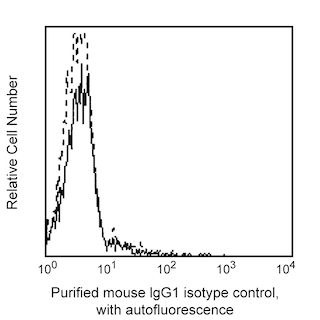Old Browser
Looks like you're visiting us from {countryName}.
Would you like to stay on the current country site or be switched to your country?






Flow cytometric analysis of EphB2 expression on human Colo-205 cells. Cells from the human COLO 205 (Colorectal adenocarcinoma, ATCC CCL-222) cell line were stained with either Purified Mouse IgG1, κ Isotype Control (Cat. No. 550878; dashed line histogram) or Purified Mouse Anti-Human EphB2 antibody (Cat. No. 564698; solid line histogram). The cells were washed and counterstained with PE Goat Anti-Mouse Ig (Cat. No. 550589). The fluorescence histograms showing EphB2 expression (or Ig Isotype control staining) were derived from gated events with the forward and side light-scatter characteristics of viable cells. Flow cytometric analysis was performed using a BD™ LSR II Flow Cytometer System.

Immunohistochemical analysis of human EphB2 expression in human placenta. Acetone-fixed, frozen human placenta sections were stained with either Purified Mouse IgG1 κ Isotype Control (Cat. No.550878; Left Image) or Purified Mouse Anti-Human EphB2 antibody (Right Image). A three-step staining procedure that employed Biotin Goat Anti-Mouse Immunoglobulin (Cat. No. 550337), Streptavidin-Horseradish Peroxidase (HRP) (Cat. No. 550946), and the DAB Substrate Kit (Cat. No. 550880) was used to develop the primary staining reagents. Original magnification:20x.


BD Pharmingen™ Purified Mouse Anti-Human EphB2

BD Pharmingen™ Purified Mouse Anti-Human EphB2

규제 상태 범례
Becton, Dickinson and Company의 명시적인 서면 승인 없이는 사용 하실 수 없습니다.
준비 및 보관
제품 고시
- Since applications vary, each investigator should titrate the reagent to obtain optimal results.
- An isotype control should be used at the same concentration as the antibody of interest.
- Caution: Sodium azide yields highly toxic hydrazoic acid under acidic conditions. Dilute azide compounds in running water before discarding to avoid accumulation of potentially explosive deposits in plumbing.
- Sodium azide is a reversible inhibitor of oxidative metabolism; therefore, antibody preparations containing this preservative agent must not be used in cell cultures nor injected into animals. Sodium azide may be removed by washing stained cells or plate-bound antibody or dialyzing soluble antibody in sodium azide-free buffer. Since endotoxin may also affect the results of functional studies, we recommend the NA/LE (No Azide/Low Endotoxin) antibody format, if available, for in vitro and in vivo use.
- Please refer to www.bdbiosciences.com/us/s/resources for technical protocols.
관련 제품




.png?imwidth=320)

The 2H9 monoclonal antibody specifically binds to the Ephrin Type-B Receptor 2 (EphB2). EphB2 is a type I transmembrane glycoprotein that belongs to the Eph receptor family of tyrosine kinase receptors. EphB2 serves as a cell surface receptor tyrosine kinase for membrane-anchored ligands referred to as type B ephrins (ephrin-B). The EphB2 receptor can bind to ephrin-B1, ephrin-B2, and ephrin-B3. Transmembrane ephrin-B family members are key regulators of embryogenesis including development of the nervous and vascular systems. The EphB2 receptor functions as a chemodirectant in regulating cellular migration. EphB2/ephrin-B interactions orchestrate cell positioning by regulating cellular adhesion and repulsion during development, thereby influencing cell fate, morphogenesis and organogenesis. Signaling can occur in a forward pathway when the EphB2 receptor tyrosine kinase is activated by bound ligand and in a reverse pathway when transmembrane ephrin-B ligands are activated by EphB2 receptor-mediated crosslinking. In the adult body, Eph receptor signaling plays major roles in regulating the architecture and physiology of different tissues under normal as well as disease conditions such as cancer. Ephrin-B1 and ephrin-B2 levels are upregulated in the vasculature during inflammation. Ephrin-B2 molecules that are localized to the luminal endothelial surface can signal through the EphB2 which is expressed by monocytes. This interaction promotes monocyte differentiation into proinflammatory macrophages. In the intestinal epithelium, EphB2/ephrin-B interactions regulate both cell positioning and tumor progression. The differential expression patterns of EphB2 allows for the detection and isolation of various intestinal epithelial cell types. These include intestinal stem cells (ISCs) which express high levels of EphB2. The 2H9 antibody reportedly blocks the interaction of EphB2 with ephrin ligands and crossreacts with mouse EphB2.
개발 참고 자료 (5)
-
Foster KE, Gordon J, Cardenas K, et al. EphB-ephrin-B2 interactions are required for thymus migration during organogenesis.. Proc Natl Acad Sci USA. 2010; 107(30):13414-9. (Biology). 참조 보기
-
Jung P, Sato T, Merlos-Suárez A, et al. Isolation and in vitro expansion of human colonic stem cells. Nat Med. 2011; 17(10):1225-1227. (Clone-specific: Flow cytometry, Fluorescence activated cell sorting). 참조 보기
-
Liu H, Devraj K, Möller K, Liebner S, Hecker M, Korff T. EphrinB-mediated reverse signalling controls junctional integrity and pro-inflammatory differentiation of endothelial cells. Thromb Haemost. 13(112)(Biology). 참조 보기
-
Mao W, Luis E, Ross S, et al. EphB2 as a therapeutic antibody drug target for the treatment of colorectal cancer. Cancer Res. 204; 64(3):781-788. (Immunogen: Blocking, Cytotoxicity, Depletion, ELISA, Flow cytometry, Fluorescence microscopy, Functional assay, Immunofluorescence, Immunohistochemistry, Inhibition, In vivo exacerbation, Neutralization, Radioimmunoassay). 참조 보기
-
Merlos-Suárez A, Barriga FM, Jung P et al. The intestinal stem cell signature identifies colorectal cancer stem cells and predicts disease relapse. Cell Stem Cell. 2011; 8(5):511-524. (Clone-specific). 참조 보기
Please refer to Support Documents for Quality Certificates
Global - Refer to manufacturer's instructions for use and related User Manuals and Technical data sheets before using this products as described
Comparisons, where applicable, are made against older BD Technology, manual methods or are general performance claims. Comparisons are not made against non-BD technologies, unless otherwise noted.
For Research Use Only. Not for use in diagnostic or therapeutic procedures.
Report a Site Issue
This form is intended to help us improve our website experience. For other support, please visit our Contact Us page.